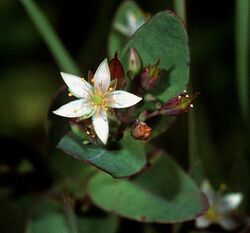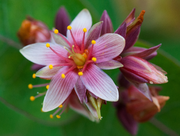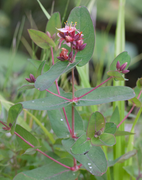Biology:Hypericum virginicum
| Hypericum virginicum | |
|---|---|

| |
| Scientific classification | |
| Kingdom: | Plantae |
| Clade: | Tracheophytes |
| Clade: | Angiosperms |
| Clade: | Eudicots |
| Clade: | Rosids |
| Order: | Malpighiales |
| Family: | Hypericaceae |
| Genus: | Hypericum |
| Section: | Hypericum sect. Elodea |
| Species: | H. virginicum
|
| Binomial name | |
| Hypericum virginicum L.[1]
| |
| Synonyms[1] | |
|
List
| |
Hypericum virginicum, the marsh St. Johns-wort[2] or Virginia marsh St. Johnswort,[3] is a species of flowering plant in the family Hypericaceae.[1] It is native to the central and eastern United States and eastern Canada.[1]
Description
Hypericum virginicum is a small herbaceous plant growing up to 70 cm (28 in) in height.[4] Its leaves are sessile and opposite, sometimes clasping. The flowers grow up to 15 mm (0.6 in) in diameter, with 5 pink or white petals.[4] It flowers in the summer to early fall and grows in bogs, wet meadows, fens, swamps, and along lakeshores.[2][4]
It can be distinguished from the closely related Hypericum fraseri by its longer, acute sepals, and longer styles.[2] The seeds of H. virginicum closely resemble those of the extinct paleospecies Hypericum tertiaerum.[5]
Taxonomy
Alexander Garden first observed this plant in 1754, but following correspondence with Jane Colden realized that she had previously collected and recorded the same species in 1753, one year before his discovery.[6] As such, Jane Colden held naming rights for what both naturalists thought would be a newly described genus. Colden generously offered to name it Gardenia in Garden's honor,[7] however this was later rejected by Carl Linnaeus when John Ellis also proposed naming the cape jasmine Gardenia jasminoides in Garden's honor.[8] As cape jasmine had been collected earlier (at least by 1680[9]) it received priority in naming.
In the end it was originally described as Hypericum virginicum by Linnaeus in 1759.[10] In 1837 Rafinesque proposed placing it a new genus, Triadenum,[11] acknowledging, perhaps unknowingly, Jane Colden's original belief that Hypericum virginicum was sufficiently unique to warrant its own genus. Members of the genus Triadenum have white to pink petals, always 9 stamens, and three staminodal glands alternating between the stamen fascicles.[11]
References
- ↑ 1.0 1.1 1.2 1.3 "Triadenum virginicum (L.) Raf.". Royal Botanical Gardens Kew. https://powo.science.kew.org/taxon/urn:lsid:ipni.org:names:30434395-2. Retrieved 2019-01-02.
- ↑ 2.0 2.1 2.2 Reznicek, A. A.; Voss, E. G.; Walters, B. S., eds (February 2011). "Triadenum virginicum". University of Michigan Herbarium. https://michiganflora.net/species.aspx?id=920.
- ↑ "Triadenum virginicum". Natural Resources Conservation Service PLANTS Database. USDA. https://plants.usda.gov/core/profile?symbol=TRVI2. Retrieved 2 January 2019.
- ↑ 4.0 4.1 4.2 Flora of North America Editorial Committee, ed. (2015), "Triadenum virginicum", Flora of North America North of Mexico (FNA), 6, New York and Oxford, http://www.efloras.org/florataxon.aspx?flora_id=1&taxon_id=220013687, retrieved 2 January 2019
- ↑ Meseguer, Andrea S.; Sanmartín, Isabel (30 June 2012). "Paleobiology of the genus Hypericum (Hypericaceae): a survey of the fossil record and its palaeogeographic implications". Anales del Jardín Botánico de Madrid 69 (1): 97–106. doi:10.3989/ajbm.2306. ISSN 1988-3196.
- ↑ Garden, Alexander (1756). "The Description of a New Plant; by Alexander Garden, Physician at Charleston in South Carolina". Essays and Observations, Physical and Literary 2: 1–5. https://books.google.com/books?id=i4xXAAAAcAAJ.
- ↑ "Jane Colden - History of Early American Landscape Design". https://heald.nga.gov/mediawiki/index.php/Jane_Colden.
- ↑ "LXXXII. An account of the plants Halesia and Gardenia : In a letter from John Ellis, Esq; F. R. S. to Philip Carteret Webb, Esq; F. R. S." (in en). Philosophical Transactions of the Royal Society of London 51: 929–935. 1759-12-31. doi:10.1098/rstl.1759.0084. ISSN 0261-0523. https://royalsocietypublishing.org/doi/10.1098/rstl.1759.0084.
- ↑ Jarvis, C. E., DuVal, A., & Crane, P. R. (2014). "Gardenia jasminoides: a traditional Chinese dye plant becomes a garden ornamental in Europe". Curtis's Botanical Magazine 31: 80–98. doi:10.1111/curt.12052. https://onlinelibrary.wiley.com/doi/abs/10.1111/curt.12052.
- ↑ "Triadenum virginicum - FNA". http://floranorthamerica.org/Triadenum_virginicum.
- ↑ 11.0 11.1 "Triadenum in Flora of North America @ efloras.org". http://www.efloras.org/florataxon.aspx?flora_id=1&taxon_id=133357.
Wikidata ☰ Q17847395 entry
 |



